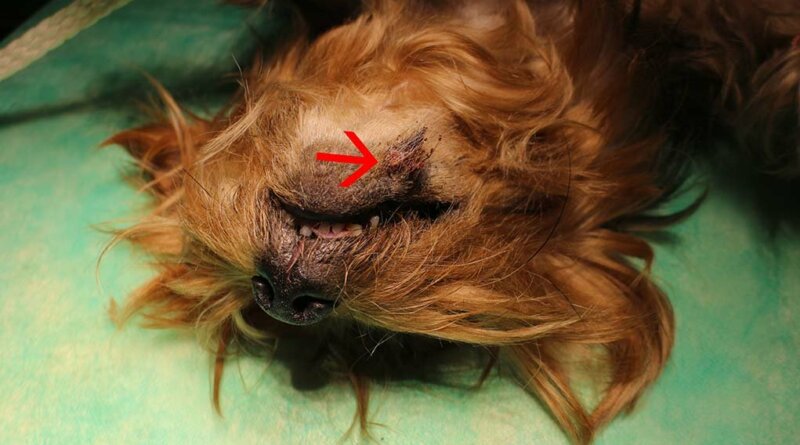Squamous Cell Carcinoma in Dogs: A Guide for Pet Owners
When caught early enough, tumors can be treated or removed, so it is vital to check your dog regularly and keep an eye out for any unusual growths. In this article we will investigate squamous cell carcinoma in dogs, so that you can recognize symptoms in your own dog and be informed of the options prior to seeing your veterinarian.
In this article we will discuss:
- What is squamous cell carcinoma in dogs?
- What are the symptoms of squamous cell carcinoma in dogs?
- What causes squamous cell carcinoma in dogs?
- How to prevent squamous cell carcinoma in dogs
- What is the treatment for squamous cell carcinoma in dogs?
What Is Squamous Cell Carcinoma In Dogs?
Squamous Cell Carcinoma (SCC) is a malignant tumor of skin cells in the epidermal layer of a dog’s skin (1). The epidermis is the outer layer of the three layers that make up the skin. It is the second most common malignant oral tumor in canines (2).
The tumor often looks like a raised area or mass of white skin, but can take on many different appearances (3). It can be located directly on the skin of the dog, or alternatively underneath the nail bed or inside of the mouth.
What Squamous Cell Carcinoma looks in a dog’s mouth:

Other places the SCC tumor can form include anywhere where squamous cells are present; for example, the dog’s paw pads, abdomen, back, ears or nose. Tumors in dogs such as this one are classified by the World Health Organization (WHO) into several classification systems (4, PDF).
What Are the Symptoms of Dog Squamous Cell Carcinoma?
It can sometimes be tricky to distinguish between a tumor and other benign lumps, ulcers, spots, bumps, cysts and sores. This is why it is always important to have your dog checked by a veterinarian for a diagnosis whenever you notice something unusual. The earlier you can get a diagnosis, the better the outcome for your dog.
Look out for the following signs (5):
- Sores, especially in areas where the dog’s fur is light-colored or white
- White growths or masses of skin
- A crusty or bleeding sore that doesn’t heal, despite being given antibiotics
- Bumps that look like warts
- Growths in the following areas: scrotum, anus, nose, toes, legs
- Pain while walking; limping or lameness
- Problems chewing or swallowing, and excessive drooling
- Swelling in the mouth, including inflammation and bleeding
- Coughing
- Loose teeth
Unfortunately, the lesions can vary quite widely in their appearance, as mentioned above, making it difficult to tell without a professional’s opinion or tests. Sometimes, they can look like small red areas of irritated or ulcerated skin. Alternatively, crusts may develop over the top. Dogs can even lose toenails.
What Causes Squamous Cell Carcinoma in Dogs?
Very few cancers have a single known cause. Most often, causes are a mixture of genetic and hereditary, environmental and risk factors. It is highly likely that exposure to UV rays and sunlight can be a big contributing factor to the development of these cancerous tumors in dogs (6).
The condition can be more common in certain dog breeds (7), like Poodles, Scottish Terriers, Boxers, Pekingese and Norwegian Elkhounds. Light-colored fur and skin, or sparsely haired dogs like white Bull Terriers, Whippets, and Dalmatians are also more at risk of SCC of the skin. SCC of the toes has been shown to affect larger dark-coated dogs like Labradors and Rottweilers.
Furthermore, dogs at higher risk of developing Squamous Cell Carcinoma are dogs between the age of 6 and 11. More studies found that dogs with compromised immune systems, large breeds and dark colored dogs (due to UV rays) are at the highest risk of developing these tumors, with one study showing that 92% of dogs with SCC being dark haired breeds (8).
How to Prevent Squamous Cell Carcinoma in Dogs
If you want to help your dog avoid developing this type of skin cancer, you should limit their exposure to the sun, especially if you have a dog with a thin coat of hair (9).
Pay particular attention to avoiding letting your dog out between the hours of 10 am and 3 pm when the sun is high in the sky and at its strongest. UV rays and sunlight play a significant role in the development of squamous cell carcinoma in dogs (10, 11, 12).
If your pet has an affected area, they should be prevented from bothering it (with the use of recovery cones or inflatable collars). The dog should not be licking, chewing, scratching, rubbing or biting at the area, as all of these actions can cause further injuries to the skin and lead to secondary infections.
In case your dog does experience secondary infections, these can be treated with antibiotics and pain medication recommended by your veterinarian.
How to Treat Squamous Cell Carcinoma in Dogs
A dog’s immune system can kill some cancer cells, but never all of them, and squamous cell carcinoma can compromise your dog’s immune system (13, 14).
Canine cancer almost never disappears on its own without any treatment; therefore, it is important to seek out a vet’s diagnosis and treatment as early as possible.
Surgical removal is the most common option, followed by radiation treatment, when it comes to treating squamous cell carcinoma on dogs (15, 16, 17). For SCC oral tumors, studies observed a 29% recurrence rate (18, 19).
Sometimes, such cancer surgery would be considered dangerous, however, such as when the cancer is affecting certain parts of the dog’s body – there are other options available in such instance (20).
Alternative treatment options for SCC:
- Cryosurgery – This involves freezing the tumor off with liquid nitrogen.
- Phototherapy – Known as light therapy, this involves brief exposure to UV light.
- Radiotherapy – This is a procedure that uses radiation to kill cancer cells.
Amputation of one or more toes may be necessary in cases of SCC of the nail bed, and part of the ear or nose may also be removed if the cancer is present in these areas.
READ NEXT: 8 Cancer-Causing Dog Products and Household Supplies (Based on Studies)
The post Squamous Cell Carcinoma in Dogs: A Guide for Pet Owners appeared first on Top Dog Tips.






I got what you intend, thankyou for posting.Woh I am delighted to find this website through google. “Spare no expense to make everything as economical as possible.” by Samuel Goldwyn.
Very efficiently written post. It will be helpful to anybody who employess it, as well as me. Keep up the good work – for sure i will check out more posts.
darkweb marketplace drug markets onion tor markets 2024